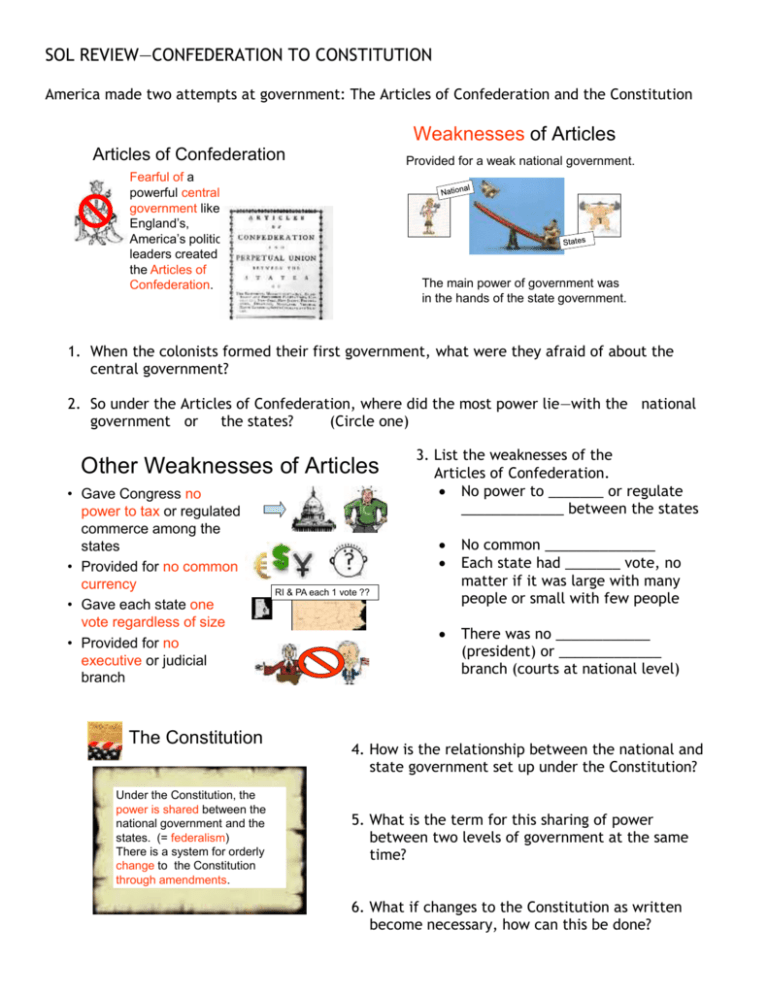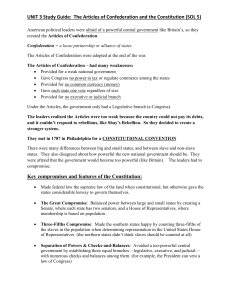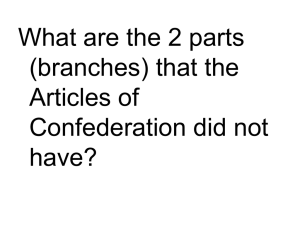Confederation to Constitution
advertisement

SOL REVIEW—CONFEDERATION TO CONSTITUTION America made two attempts at government: The Articles of Confederation and the Constitution Weaknesses of Articles Articles of Confederation Provided for a weak national government. Fearful of a powerful central government like England’s, America’s political leaders created the Articles of Confederation. The main power of government was in the hands of the state government. 1. When the colonists formed their first government, what were they afraid of about the central government? 2. So under the Articles of Confederation, where did the most power lie—with the national government or the states? (Circle one) Other Weaknesses of Articles • Gave Congress no power to tax or regulated commerce among the states • Provided for no common currency • Gave each state one vote regardless of size • Provided for no executive or judicial branch The Constitution Under the Constitution, the power is shared between the national government and the states. (= federalism) There is a system for orderly change to the Constitution through amendments. 3. List the weaknesses of the Articles of Confederation. No power to _______ or regulate _____________ between the states No common ______________ Each state had _______ vote, no matter if it was large with many people or small with few people There was no ____________ (president) or _____________ branch (courts at national level) RI & PA each 1 vote ?? 4. How is the relationship between the national and state government set up under the Constitution? 5. What is the term for this sharing of power between two levels of government at the same time? 6. What if changes to the Constitution as written become necessary, how can this be done? The creation of the Constitution involved many debates over certain key issues. The issues were settled through compromises. Key Issues Resolution Federal laws are supreme when constitutional but the states have considerable power to govern themselves. Enumerated Powers Shared Powers Reserved Powers Key Issues Resolution The power of Congress was limited to those identified in the Constitution = Enumerated Powers 7. What are the three types of power? Those listed for just the federal government = ___________________ powers Those that belong only to the states = ________________ powers Those that both levels have = are _____________ powers Key Issues Resolution • • • • • Lay and collect taxes Borrow money Regulate commerce Coin money Establish naturalization procedure • Declare war • Establish and maintain an army and navy • And do whatever is necessary and proper to carry out these duties Each state has 2 Senators Power was balanced between large and small states by creating a Senate with equal representation and a House of Representatives with members based on population There can be several Representatives from large state 8. Which level of government has the enumerated powers? List some. 9. Under the Articles, each state, large or small, had ________ vote. How does the Constitution balance the power of large and small states in Congress? Large states have greater power in the ________________________ because the number of representatives is based on __________________ Small states have equal power in the _________________ because each state has _____ Senators Remember to pass a law it needs to pass in both the House of Representatives and the Senate 10. How many Senators does Virginia have? Key Issues Resolution Key Issues Resolution To avoid a too-powerful central government three co-equal branches were established: legislative, executive, and judicial. To please Southern slave-holding states, 3/5 of slaves were able to be counted when determining the number of Representatives. = The Three-fifths Compromise There are many checks & balances among the three branches. 11. How did the Constitutional Convention solve the issue of counting slaves when determining the number of Representatives for Congress? 12. What is the name of this compromise? 13. What problem does the “checks and balances” system solve? 14. What are the three branches of government? Key Leaders at Constitutional Convention George Washington was the President of the Convention but seldom participated in debate. James Madison led the debate and kept a record of the meetings. He wrote the “Virginia Plan” which became the foundation for the structure of the new government. Later, he wrote much of the Bill of Rights. He’s the “Father of the Constitution.” Bill of Rights—Virginia’s Contributions George Mason wrote the Virginia Declaration of Rights. It held the basic idea that human rights should not be violated by government. Thomas Jefferson wrote the Virginia Statute for Religious Freedom. It outlawed the “established church” or the support of government for one favored church. 15. What role did George Washington have at the Constitutional Convention? 16. Why is James Madison known as “the Father of the Constitution”? He kept a ___________ of meetings He wrote the ____________ Plan for the ____________ of the new government He wrote the ______ ___________(the first 10 amendments to the Constitution) 17. Two other Virginians were major contributors. Explain what each did. George Mason wrote the________________________ which was a model for the Bill of Rights Thomas Jefferson who wrote the __________________________ that outlawed the “___________” church— government support for a church Bill of Rights—Virginia’s Contributions James Madison consulted both Virginia’s Statute of Religious Freedom and the Declaration of Rights when drafting the first ten amendments that became the Bill of Rights. 18. Match the Virginians to their contributions. ____ Father of the Constitution A. George Mason ____ Wrote the Virginia Declaration B. Thomas Jefferson of Rights ____ President of the Constitutional C. James Madison Convention ____ Wrote the Bill of Rights D. George Washington ____ Wrote the Virginia Statue of Religious Freedom Ratification There were major arguments FOR and AGAINST the Constitution between the Federalists and AntiFederalists. Elements of both viewpoints are reflected in present-day issues like the size and role of government, federalism and individual rights. Ratification Debate Today Today, more conservative thinkers echo the AntiFederalist concerns. They speak out for liberty, individual initiative and free markets 19. Which group was for ratification? The ___________________; which group was against ratification? The ___________________. 20. What are this issues, like those of today, that divided Federalists and Anti-Federalists? 21. Which group of today’s politicians resemble the Anti-Federalists? The __________________ because they believe in _______________, individual ________________ and _________ markets. KEY CHANGES MADE BY SUPREME COURT The Supreme Court under Chief Justice, Virginian John Marshall made three significant rulings. These rulings still impact our law today. A Co-Equal Supreme Court It was the rulings of Chief Justice John Marshall of Virginia (served 1801-1835) that strengthened the role of the Supreme Court as an equal branch of the national government. •Marbury v. Madison—judicial review •McCulloch v. Maryland—use of implied power 22. What was Chief Justice John Marshall’s lasting impact on the role of the Supreme Court in the system of checks and balances? He strengthened the role of the _______________ _________ as a _______________ branch of the ________________ government •Gibbons v. Ogden—national view of economic affairs Case Foundations Today Marbury v. Madison Gibbons v. Ogden McCulloch v. Maryland The above three cases laid the foundation for the Court’s authority to mediate disagreements between --branches of government, --levels of government and --competing business interests. Laid the __________________ for the Court’s authority to _______________ disagreements 23. State the result of each case. Marbury v.Madison = ____________________ (the Court can declare laws of Congress unconstitutional) McCulloch v. Maryland = ____________________ (the list of enumerated powers of the Congress can be “stretched” if necessary to carry out the duties of Congress) Gibbons v. Ogden = National view of ______________ activity (the national government will regulate interstate commerce 24. Put the case name on the blank with the type of mediation disagreements: between Branches of government = __________________ v. __________________ Levels of government = ______________________ v. ____________________ Competing business interests = ________________ v. _________________ ARTICLES OF CONFEDERATION AND CONSTITUTION Cause and Effect Weak national gov’t, no power to tax or regulate trade, no common currency, no executive or judicial branch Constitutional Convention Successful adoption of U.S. Constitutionmodel for the rest of the world Terms Articles of Confederation—First constitutional gov’t of U.S., weak nat’l gov’t, other faults George Washington—Presided at Constitutional Convention; lent prestige, 1st President James Madison—“Father of the Constitution,” proposed Virginia plan, wrote Bill of Rights 3/5 Compromise—to please South, counting 3/5 of slaves when determining population for representation Separation of Powers/ Virginia Plan—three co-equal branches to avoid too powerful central gov’t Checks and balances—each branch has checks on others to balance power among branches Federalism—federal law supreme with states having considerable leeway to govern themselves Enumerated/delegated powers—powers listed to federal gov’t specifically in Constitution Great Compromise (large state/small state)—2-house legislature; Senate equal representation, House based on population Federalists—pro Ratification of Constitution, Bill of Rights redundant Anti-federalists—against ratification of Constitution because it did not include Bill of Rights, too much power at national level Virginia Declaration of Rights—model for Bill of Rights, written by George Mason; basic human rights should not be violated by the government Virginia Statute for Religious Freedom—written by Thomas Jefferson, outlawed established (gov’tsupported) church Bill of Rights—first ten amendments of Constitution guaranteeing basic rights Matching __Northwest Ordinance A.1786—separates church and state; establishes freedom of worship __Annapolis Convention B. Agreement that slaves would count less than a full person __James Madison C. Agreement—House by population, Senate 2 per state __George Mason D. 1776—says basic human rights cannot be violated by government __Great compromise E. Key phrase of “elastic clause,” stretches meaning of Constitution __3/5 Compromise F. Created 1787, followed Art. of C., supreme law of the land __”…necessary & proper…” G. Meeting pointed out defects in Articles of Confederation __U.S. Constitution H. Virginian known as “Father of Constitution,” also wrote Bill of Rights __Virginia Declaration of Rights I. Virginian wrote VA Declaration of Rights used as model for U.S. Bill of Rights __Virginia Statute of Religious J. 1787—one success of Articles; organized territories near Great Freedom Lakes








